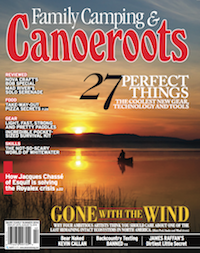Identfying river features and knowing how to manage them is the key to paddling safe lines and having fun. If your next tripping route has sections of swift flowing water or rapids, these are some of the most common features and obstacles you need to be aware of before taking the plunge.
TONGUE
When considering where to enter a rapid look for the tongue—clear and fast moving dark water that forms a V-shape pointing downstream. Usually it marks the channel of deepest water and can indicate a safe place to enter. Tongues sometimes end in wave trains, three or more similarly sized and evenly spaced waves, often dark in color with crashing white tops.
ROCKS
Moving water wouldn’t be much fun without rocks to create river features, but sometimes they get in the way. If you hit a rock, control the collision by keeping your paddle in the water for stability and redirect your bow back into current. If you find yourself broad side to a rock, lean and tilt your canoe towards it and slide around. Don’t lean upstream, this will swamp your boat and could cause it to wrap. Beware of lone waves in the river as they can indicate a rock is hiding below the surface.
HYDRAULICS
Also known as holes, these river features recirculate water downstream of ledges. Hydraulics can be fun play spots, but larger ones can be nasty sticking points for boats or, worse, paddlers. If you miss your intend- ed route and have to paddle through one, point your boat downstream and keep pad- dling. The key to avoiding a capsize or get- ting stuck is to pierce the hydraulic with the bow of your boat and maintain momentum.
EDDIES
Downstream of exposed rocks and river bends, calm pools called eddies form where the water recirculates back behind the obstacle. They can give canoeists a chance to pull out of the current to rest or scout the next section of river. To enter or exit you’ll need to cross the eddyline—where the main flow meets the calm pool—with momentum.
STRAINERS
Created by trees that have fallen into current, the hazard is caused by water rushing amongst branches and through unyielding limbs. The force of water can trap paddlers and their gear and make rescue and recovery very difficult and extremely dangerous.
The first step to avoiding them is ensuring you have a clear view downstream before running a rapid. If you spot a strainer, choose a line that matches a deep-water current that directs well away. Take no chances, if there’s not a line that gives you a wide berth, get out and portage.
Paddling whitewater is a specialized skill and there are plenty of other hazards to be aware of if you’re taking on big rapids, including undercuts, recirculating eddies and sieves. There’s no substitute for on-water instruction by a trained paddler to ensure your river journey is a fun and safe one.
Andrew Westwood is an open canoe instructor at the Madawaska Kanu Centre, member of Team Esquif and author of The Essential Guide to Canoeing. Find him at www.westwoodoutdoors.ca.
 This article first appeared in the Early Summer 2014 issue of Canoeroots Magazine. For more great content, subscribe to Canoeroots’ print and digital editions here.
This article first appeared in the Early Summer 2014 issue of Canoeroots Magazine. For more great content, subscribe to Canoeroots’ print and digital editions here.



